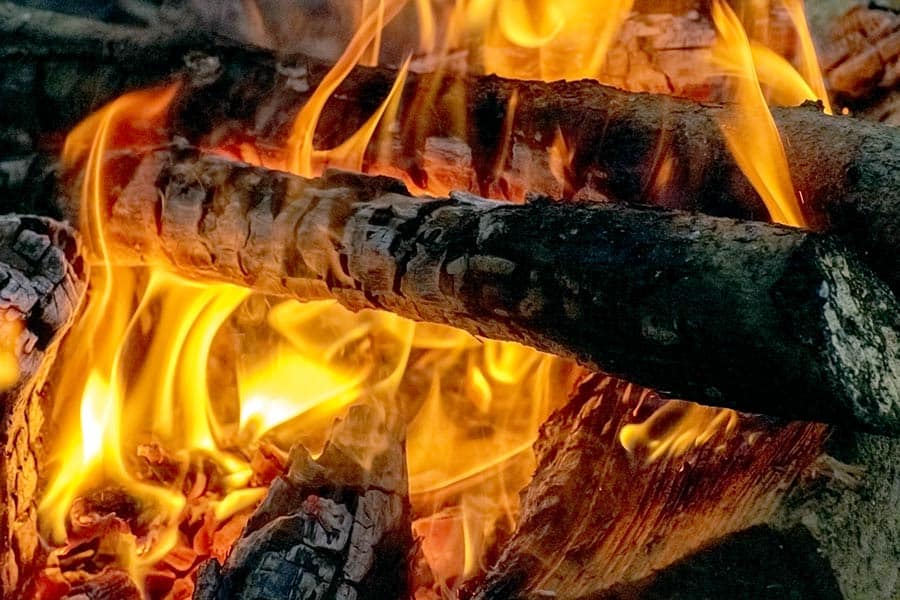
Cooking over a campfire can be a fun experience, but getting your food cooked just right can be tricky. Whether you’re using a cast iron skillet, Dutch oven, or other heavy-duty cookware, some tips and tricks can help you create hassle-free meals cooked to perfection.
In this post, we’ll explore tips for cooking over a campfire, from building the perfect fire to using the right equipment and techniques to create finger-licking meals. So grab your fire starter, and let’s get cooking!
1. Plan Ahead
Creating a menu ensures you have all the necessary items for cooking great campfire meals. It’s important to plan your meals and make a list of ingredients for each dish before leaving for your camping trip.
Planning will keep you organized and reduce the chances of forgetting necessary items. Additionally, having a list will help you to avoid a trip to the nearest grocery store for something you forgot.
2. Bring the Right Equipment
When cooking over a campfire, you’ll want to bring durable and heat-resistant pots or pans. A cast iron skillet or Dutch oven is an excellent option as they are designed to withstand high temperatures and distribute heat evenly.
Investing in heat-resistant oven mitts or gloves is advisable to protect your hands from hot cookware, flames, and embers.
When cooking, avoid using plastic utensils; they can easily melt. Opt for metal or wood instead. Having the right tools can make a significant difference in how successful your outdoor cooking experience is.
3. Start Your Fire Early
Before meal time, build your fire using the proper fire-building technique. Starting the fire early and letting it burn down to hot coals will enable you to cook meals easily.
The hot coals provide consistent heat, perfect for cooking. Once you’ve reached this stage, place your pots or pans on a grate over the hot coals, and you’re ready to cook.
Cooking over hot coals will also help reduce the fire’s smoke, allowing you to cook without excessive smoke chasing you around the firepit.
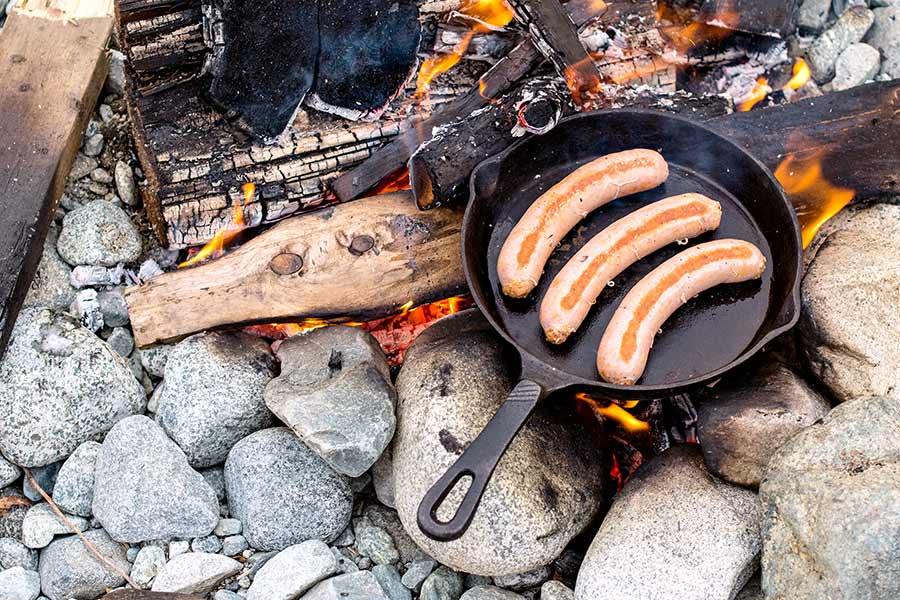
4. Cook with Cast Iron
Cast iron is a fantastic choice for cooking on a campfire, where heat is unevenly distributed and challenging to control. Cast iron skillets and grill/griddles distribute heat evenly, ensuring your food is cooked consistently.
Also, cast iron cookware is durable, making it an ideal option for cooking in various outdoor conditions. With some seasoning, it can also be non-stick, meaning less oil is required while cooking, making it easier to clean when compared to other types of materials. Cast iron cookware offers exceptional versatility, functionality, and durability, making it an essential piece of camping gear.
5. Control the Heat
One of the benefits of cooking over a campfire is that you can adjust the heat of your fire to control the cooking temperature of your pot or pan.
To increase the heat, move your cookware closer to the flames, and to decrease heat, move it away from the fire. Adjusting the distance of your cookware is a simple way to regulate your cooking temperature and prevent your food from burning or undercooking.
You can also control the heat of your fire by adding or removing wood as needed. If your fire is too high or hot, remove some wood. If your fire is too low, it may be necessary to add more wood to increase the heat. By keeping an eye on your fire’s size and adjusting the placement of your cookware, you’ll be able to create the ideal cooking temperature for each dish.
Remember always to use caution when adjusting your fire, and keep a safe distance from flames or hot coals.
6. Pre-Cook
Prepping ahead with some pre-cooked, reheatable meal components can save time when preparing a campfire meal.
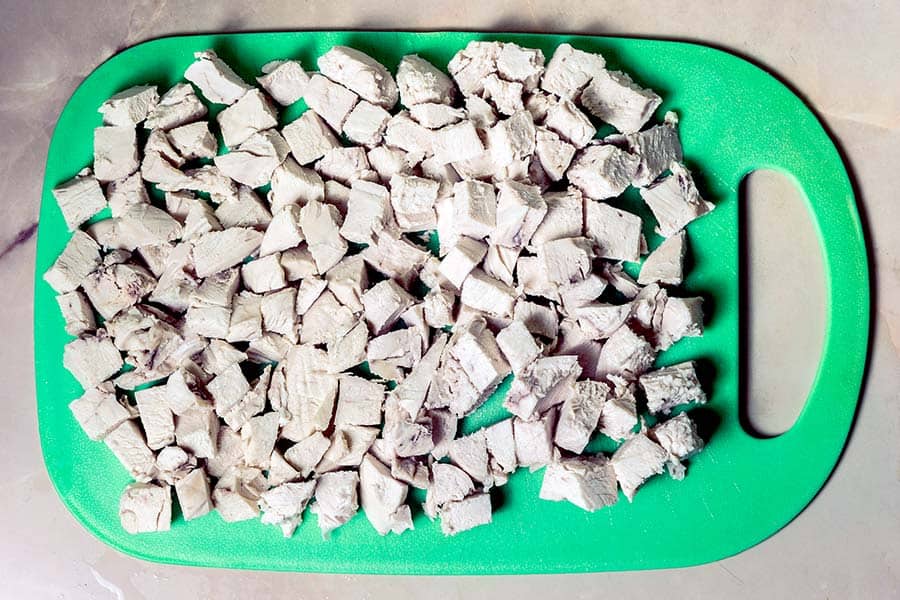
Pre-cooked chicken breast or steak can be sliced, and vegetables like potatoes can be pre-cooked beforehand. Then, once you are ready to eat, you can reheat them over the fire by placing them in a pan on the cooking grate.
Pre-cooking meat or veggies is an excellent way to create quick, easy meals without compromising flavor.
7. Use the Proper Cooking Techniques
Simple cooking techniques like grilling, roasting, or boiling are ideal for preparing meals perfect for camping trips. Stick to simpler recipes requiring fewer ingredients because complicated recipes can be challenging to manage over a campfire.
Grilling is cooking food on a grate over an open flame or hot coals, resulting in a smoky flavor that makes your meal even more flavorful. Roasting involves cooking food on a stick or skewer over hot coals while boiling involves cooking food directly in a pot or hanging it from a tripod over the fire.
8. Practice Food Safety
Maintaining proper food hygiene is essential to prevent foodborne illness while cooking.
Always wash your hands thoroughly before handling any food or utensils to ensure that any bacteria or germs on your hands do not contaminate the food you are about to cook or have already cooked.
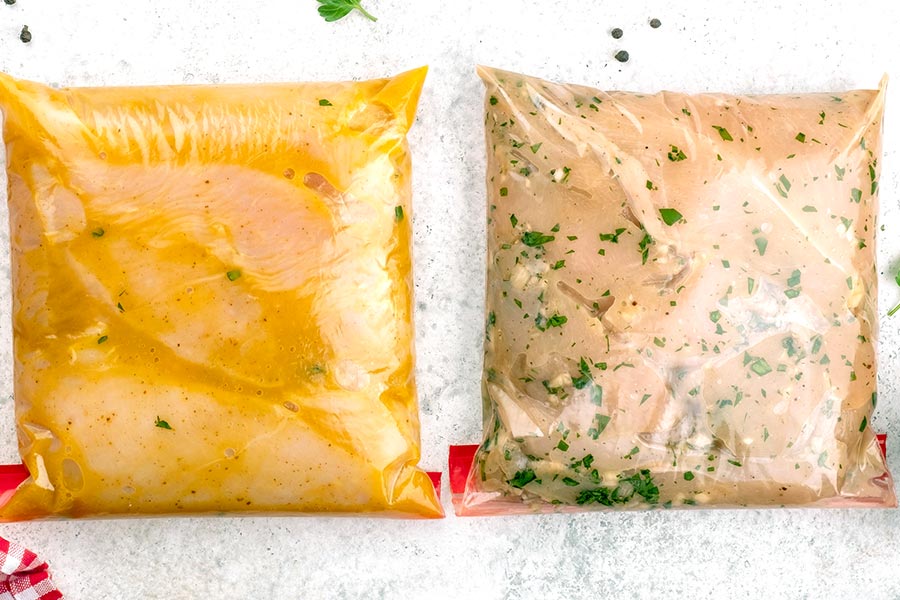
Remember that raw meat or poultry should be handled separately and packed in airtight containers before being placed back in the cooler or camping fridge.
Cook meat products thoroughly to prevent the spread of bacteria that can cause foodborne illnesses. Once your meal is ready to serve, store any leftover food properly in airtight containers or bags to prevent spoilage or contamination.
9. Minimal Prep Meals
When camping and cooking over a fire, it’s important to plan meals that require minimal preparation and cooking time. Hot dogs, burgers, or grilled sandwiches are great options for cooking because they require minimal effort but still taste delicious. Preparing these meals is easy – all you need is the ingredients and your trusty campfire.
With hot dogs, burgers, or grilled sandwiches, you can quickly have a meal on the table without spending too much time preparing it. So the next time you’re out camping, remember to include these options in your menu.
10. Windbreak
When cooking, use a windbreak to protect the flames and control the heat. Using a windbreak is especially important during windy conditions, as high winds can cause the fire to get out of hand and decrease your control over your food.
Windbreaks are easy to make and provide an effective barrier that helps keep flames from getting too wild. You only need a few pieces of wood or other materials to create a wall to help block strong gusts and allow you to maintain steady heat for optimal cooking results.
11. Use a Tripod
When cooking with a Dutch oven or a heavy pot, one of the best ways to manage cooking is by hanging it from a stable structure.
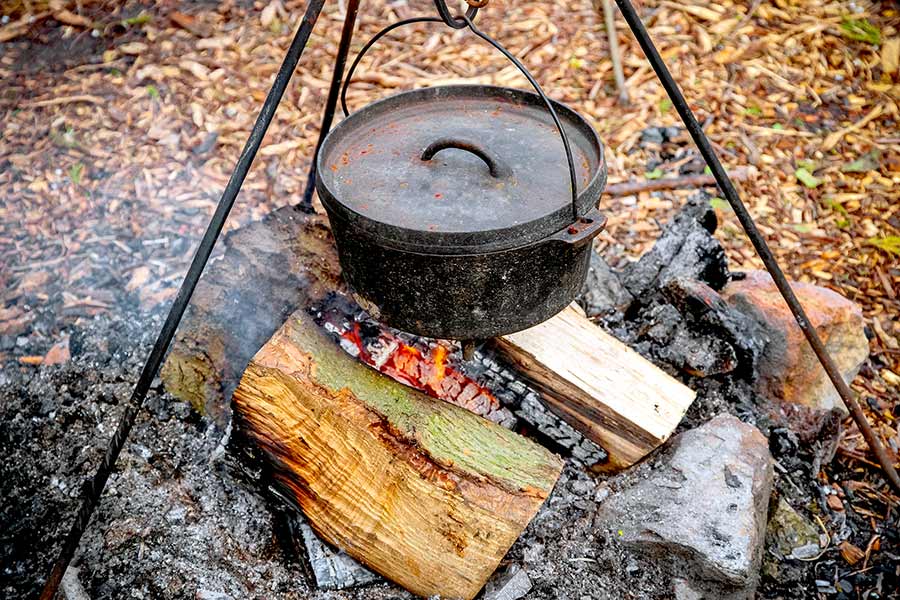
A tripod, for example, is a helpful tool that can be placed over the fire pit to provide a sturdy frame to hang your pot from. Using a tripod keeps the pot stable and lets you easily rotate it, allowing for even cooking and preventing hot spots.
Additionally, you can adjust the height of the pot using the tripod’s chain to regulate your cooking temperature, making it ideal for simmering stews and soups.
Other structures can be used too, but they must be sturdy enough to hold up the weight of the pot and the food while ensuring that they remain safe for preparing food.
Other Posts of Interest
- 14 Features To Look For When Buying A Van For Camping
- How Glamping Is Different From A Traditional Hotel Stay
- Are There Grizzly Bears In Acadia National Park?
- What Is An Inverter In A Camper Van?
12. Grates and Skewers
Grilling grates or skewers are excellent for cooking food over an open flame.
Grilling grates can be placed over the campfire to cook meat and vegetables. They are typically made of durable stainless steel, which resists warping; they come in various sizes, depending on your fire pit size, and are easy to clean.
On the other hand, skewers are ideal for cooking smaller food items like kebabs or other items. Simply skewer the food and place it over the heat to cook evenly. Skewers can be made of metal, bamboo, or even wooden sticks.
When cooking with grilling grates or skewers, it’s essential to rotate the food occasionally to prevent overcooking and allow thorough cooking. When finished cooking, set the grate aside to cool down before cleaning to avoid getting burned.
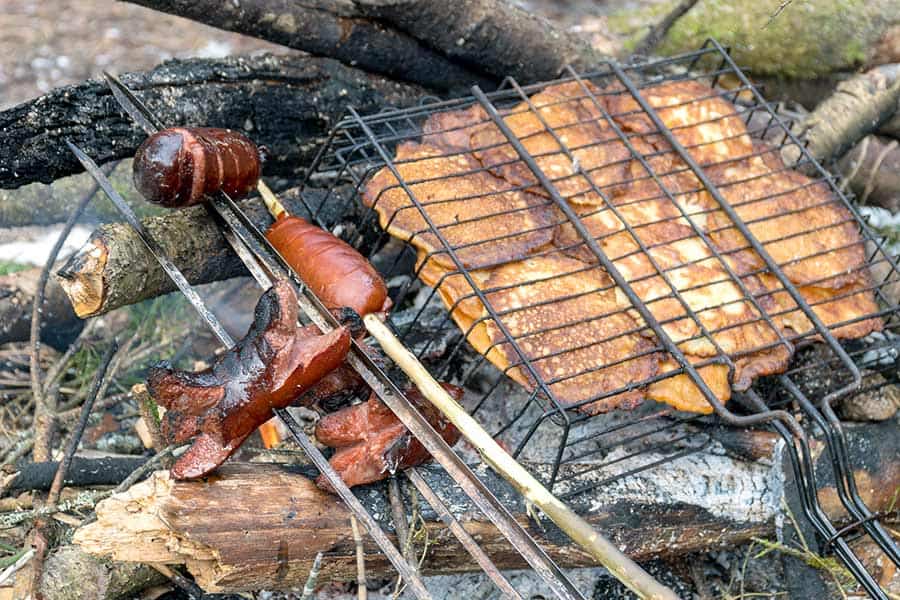
13. Avoid Cooking Directly Over Flames
When cooking over a campfire, it’s essential to avoid cooking your food directly over flames. Flames are incredibly erratic, and cooking directly over them can cause uneven cooking and burnt food.
Instead, wait until the flames die down and are replaced by hot coals. Hot coals produce an even, consistent heat that helps to cook food evenly without burning it. In addition, cooking over hot coals allows for precise temperature control, making it ideal for preparing various dishes, from steaks to soups.
If cooking over hot coals is impossible, try using heat-resistant foil or a cast iron skillet to create a buffer between the flame and the food. This will help insulate the food from the direct heat of the fire, preventing it from burning.
By avoiding cooking directly over flames and using hot coals or other buffers, your food will be prepared evenly, with a perfect balance of smoky flavors, and ready to eat in no time.
14. Spray Bottle
A water bottle filled with water allows you to spray down flare-ups quickly. For example, as you cook, meat drippings or oil can cause flames to flare up and cause your food to cook unevenly or even burn. You can control the flames with a few squirts of water.
15. Long-handled Utensils
Long-handled tongs, a spatula, a spoon, and a fork are essential for cooking over a campfire. Their long handles provide a safe way to rotate and flip food while keeping your hands away from the flame. Plus, they come in handy when you need to move coals around.
When using these utensils, make sure that their handles allow you to be a safe distance away from the fire so that you are not at risk of getting burned.
For smaller items like fish fillets or vegetables, consider investing in a metal grilling basket or wire mesh grate so that you can easily turn these types of things without them falling through the grate.
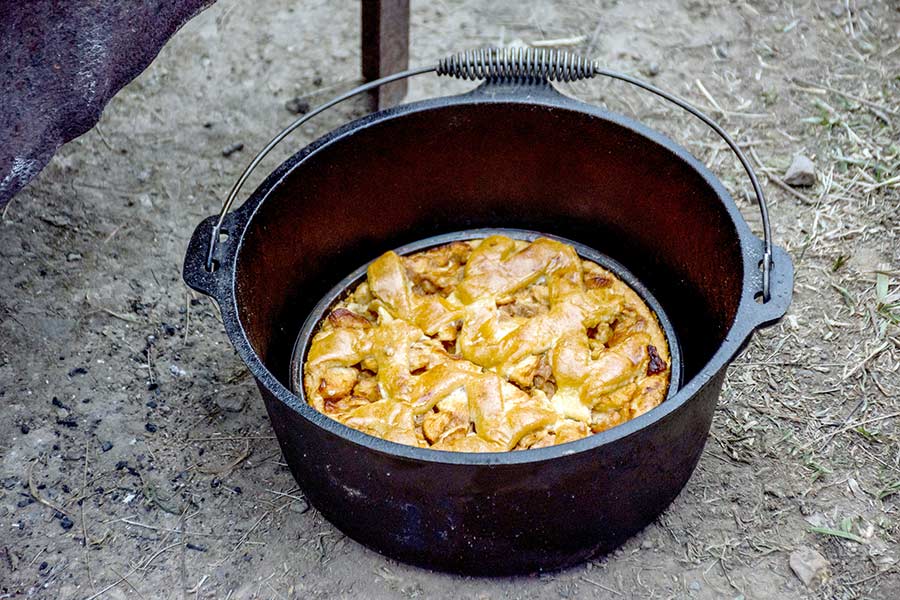
16. Utilize Dutch Ovens
A Dutch oven is a great tool to have on hand when camping, as it allows you to make soup, stews, bake bread, biscuits, or desserts over the campfire.
To use a Dutch oven, you first need to make sure that your fire is hot enough. Then, once the heat has reached the desired level, you can hang your Dutch oven over the fire, set it on a grate above it, or over coals.
With this setup, you will be able to get consistent heat so that everything cooks evenly. Plus, because most Dutch ovens come with lids, they keep ash out and help retain moisture inside while allowing some steam to escape – perfect for baking items like bread or cake.
17. Pie Iron Cooking
Pie iron cooking is an easy and fun way to make food. It involves using two metal plates with a handle connected with hinges, which are then used to create sandwiches, pizzas, quesadillas, and even pies.
To use a pie iron for cooking:
- Insert ingredients inside the plates and close them.
- Hold the pie iron directly over your campfire and wait until it’s hot and toasty.
- Turn it over halfway through so that both sides are evenly cooked.
Pie iron cooking is great because it allows you to create meals without much effort. Plus, cleanup is super easy; just brush off any excess ash or dirt before putting away your pie iron. So, bring your pie irons next time you’re camping.
18. Cover It
Using a cover or lid is a technique for even heat distribution when cooking with a Dutch oven or skillet. When covering the pan, make sure that the lid or foil completely covers the surface. Covering will keep the heat in the pot and allow food to cook faster.
19. Making Coffee
For coffee lovers, there’s nothing quite like having a fresh pot of coffee made over the campfire in the morning. And with the right tools and techniques, you can make coffee with just a metal camping percolator.
Add water to the pot, don’t fill past the pouring holes. Place the brew basket on the perk stem, and if desired, place a filter in the bottom of the basket.

Add ground coffee into the basket, begin with 1 tablespoon of coffee for every cup of water. It will take a little bit of trial and error to get the right amount of coffee to suit your taste. (Do this outside the pot, or coffee will go down the stem hole and get into your coffee.)
Place the lid on top of the basket and then put the perk assembly into the coffee pot—place the pot over low to medium heat. Watch the pot, and you will see the coffee begin to perk through the knob on the top.
Let the coffee perk for 5 to 7 minutes until it reaches the strength you want.
When pouring, use a mitt so you don’t get burned, and make sure to keep the lid closed, so coffee grounds don’t get into your coffee.
20. S’mores
When making s’mores over a fire, use a long sturdy stick or skewer to roast your marshmallows evenly. Hold the marshmallow above the flame rather than directly in it, and rotate it frequently for even toasting.
Once the marshmallow is golden brown, carefully remove it from the stick and place it between two graham crackers with a piece of chocolate. Wait a few seconds for the chocolate to melt before taking a bite.
21. Backup Plan
When camping, it’s always wise to be prepared for inclement weather — especially if you’re cooking your meals over an open campfire. A portable camping stove can be a great backup plan in case of rain or high winds.
Today’s camping stoves are designed for durability and portability, making them easy to transport and set up anywhere.
Be sure to bring extra fuel, such as propane tanks, so you have enough on hand to cook all your food in case bad weather prevents you from lighting a fire. And with most models, you’ll be able to control the temperature easily with adjustable temperature settings.
In case of an accident: When cooking over a campfire, it’s essential to keep a first aid kit close by in case of any burns or injuries. Open fires can cause harm if you aren’t paying attention, so having an emergency kit can help you prepare for unexpected accidents.
Your first aid kit should include bandages, gauze pads and rolls, adhesive cloth tape, alcohol wipes, antiseptic ointments, antibiotic creams, and over-the-counter pain medications.
Always check the contents of your first aid kit before leaving for your trip — if something is missing or used up along the way, be sure to find a suitable replacement immediately to prevent any medical emergencies while you’re out in nature. Additionally, consider bringing along a fire extinguisher in case of an accident with flames.
A Rewarding Experience
Whether you’re grilling hot dogs, roasting marshmallows, or baking bread in a Dutch oven, creating a meal over a campfire creates a sense of satisfaction. While there are challenges, with some preparation and the right tools, anyone can become a campfire cooking pro. So the next time you’re out camping, don’t be afraid to try your hand at cooking over a campfire – it’s worth it!






